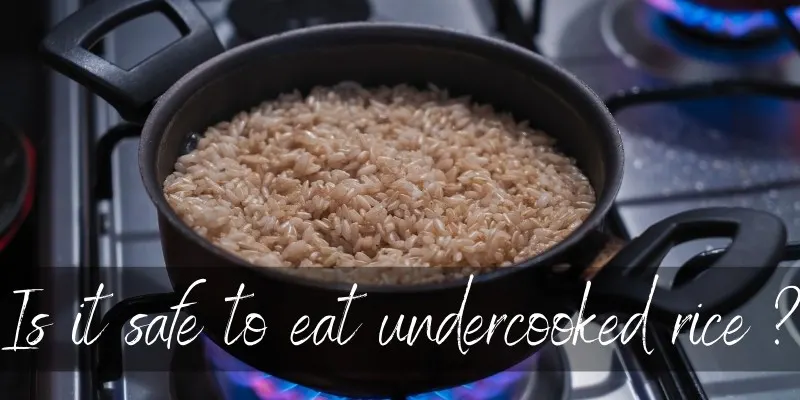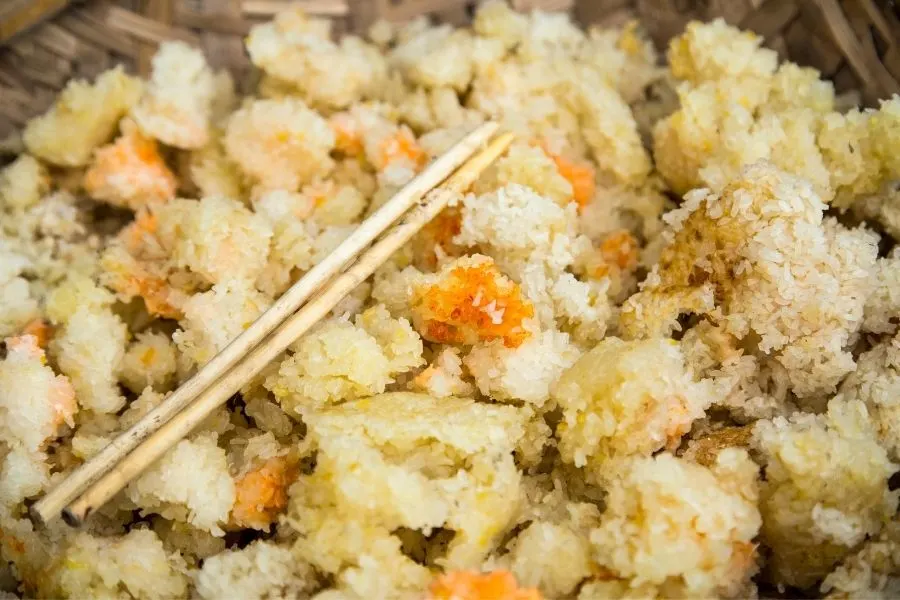Rice is a staple food in the diets of billions of people around the world. Most Asian countries are avid rice lovers. Their love for rice has reached the West and now rice is a kitchen staple.
Since it’s such a common food, we also need to discuss basic questions about cooking rice. Today we’re going to talk about whether it’s safe to eat undercooked rice.
After all, not everyone’s a rice pro, and sometimes we may judge poorly just when the rice is fully cooked.

Is it safe to eat undercooked rice ?
Undercooked rice may cause health concerns like food poisoning, so it’s best not to eat it. You should continue cooking it, add water if necessary.
Raw rice is completely unsafe, as it may harbor bacteria. Brown rice in particular is unsafe as raw, because the bran is raw and this leads to digestive problems, aside from bacterial infections.
Partially cooked rice may or may not harbor bacteria, but indigestion may still occur.
You’ll know the rice is undercooked if it’s starchy and dry when you eat it. The most common problem is rice cooked on the outside, but dry in the middle.
Read Also:Why Is Fried Rice Called Fried Rice ?
Is it safe to eat al dente rice ?
Al dente rice is safe to eat, as the starch has softened and the rice is fully cooked through. It feels tougher because it hasn’t started breaking apart and puffing out, but it is safe to eat.
You’ll know your rice is al dente if you take a few grains and they are easy to eat without being mushy. You can increase your chances of this happening by using short grain rice.
This kind of rice cooks evenly all around, and it is easy to notice when it’s fully cooked.
How to tell your rice is fully cooked
Whenever you’re cooking white rice (except basmati and jasmine) you need to use 1 part rice to 3 parts water. If you want it extra fluffy, mushy even, then use 4 parts water.
So that means for every 1 cup of plain, white rice you will need 3 cups of cold water.
Add everything to a saucepan or pot, and bring to a boil. You’ll know your rice is fully cooked when the grain is somewhat seethrough. When you put the rice in water, it will be white and opaque.
When the rice starts cooking, it will become translucent at the edges, and the middle will be stark white by comparison.
Once you see the stark white in the middle disappear, it is done. Of course, it’s best to taste the rice as you go, a couple of grains at a time. This is crucial if you’re only just starting with rice as an ingredient, you need to learn to judge the doneness by looking at it.
Basmati or jasmine rice
Basmati and jasmine rice have the same cooking time, and you will need to use 1 part rice to 2 parts water. Put everything in a saucepan, bring to a boil, and then immediately bring it to the lowest setting.

Do not stir, at all, under any circumstances. Find something else to do in the meantime, but remember to set a timer.
It takes about 20 minutes for a cup of basmati or jasmine to fully cook through. You may cover the pot if you like, to make sure the top grains remain moist as well.
Basmati and jasmine are ‘dry’ rice, in that they work best as steamed rice and they won’t get that watery, saucy consistency you can get from plain white rice.
Brown rice
Brown rice is more difficult to cook, and you need to use a 1 to 4 rice to water ratio. Bring to a boil, then let simmer on low, and cover the pot. It can take anywhere from 40 minutes to an hour.
Resist boiling it on high heat, it will only evaporate the water and the rice won’t be done. This kind of rice just takes time.
Brown rice still has the bran on the grain, this means it takes much longer to cook because the bran ‘jacket’ must peel off. This also brings more nutrients like vitamins and minerals.
Keep in mind that even fully cooked brown rice will be firmer than plain white rice.
Wild or red/black rice
If you’re using wild or red rice, use the same method as brown rice but be very patient. It can take even longer, especially if using red or black rice which will also stain absolutely everything. We hope you like purple.
A good indication the rice is cooked is when the dark jacket opens up to reveal the white rice inside. If the jacket is turned over backwards and you see more white than jacket, the rice may be overcooked.
Rice dries out after cooking
Once you’re done cooking the rice, it will start to cool down and lose moisture. This means that after a few hours – about 12 – the rice will start to dry out and become hard.
While it’s still cooked rice, it will become dry and crunchy and really difficult to eat.

For this reason it’s best to store your rice in a container with a tight lid, or at least place some clingfilm directly on it when it’s cool.
Okay, but can you eat cooked and then dried rice ? Well, the main problems were the possible bacteria on raw rice and the uncooked starch and cellulose.
In this case, the rice is already cooked so those problems don’t exist anymore. However we strongly advise you to not eat cooked and dried rice. It’s just as difficult and pointless as eating raw rice.
You can, however, eat rice crispies or rice puffs if you really want cooked, dry rice.
Read Also:Why Is Popcorn A Movie Snack ?
Final thoughts
As the above discussion shows, it’s a bad idea to eat raw or undercooked rice, whether in small or larger amounts – especially if you do so regularly.
In the short term, there will be some unpleasant side effects. If you keep it up, some serious, even chronic, health issues may crop up. If someone you know has a compulsive urge to eat raw rice, you should ask them to seek medical help.

